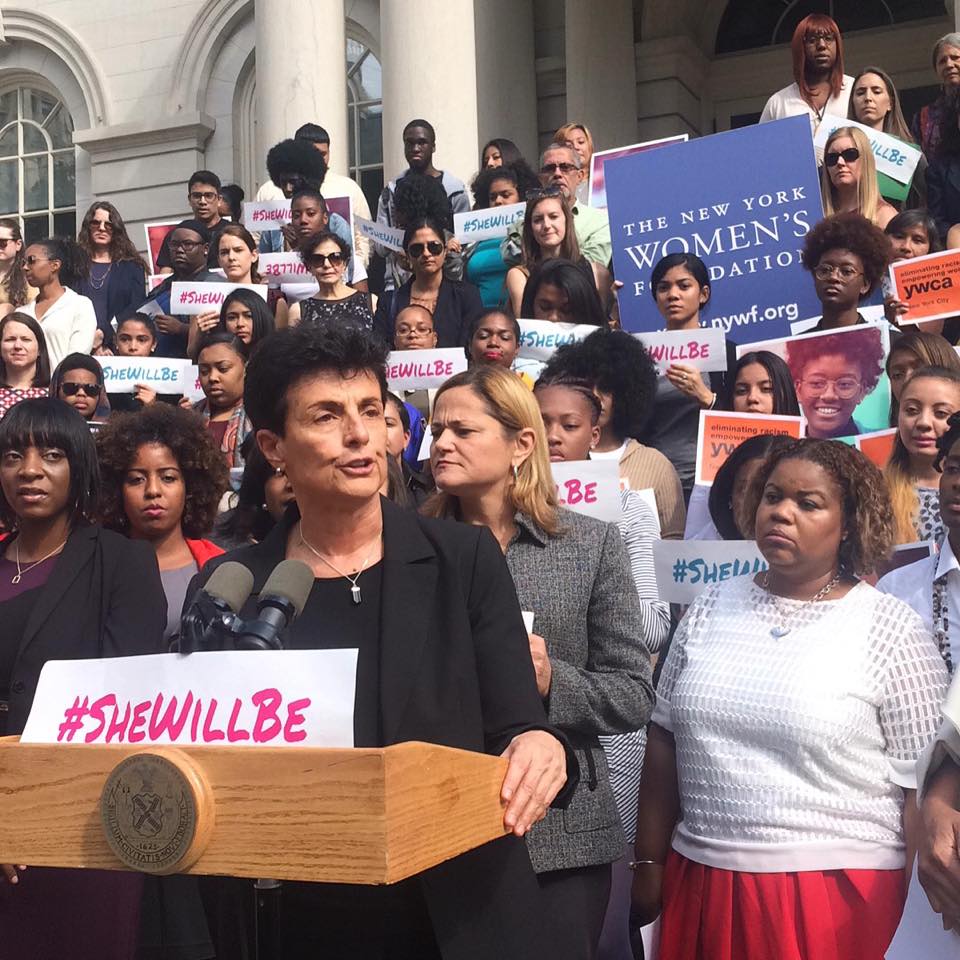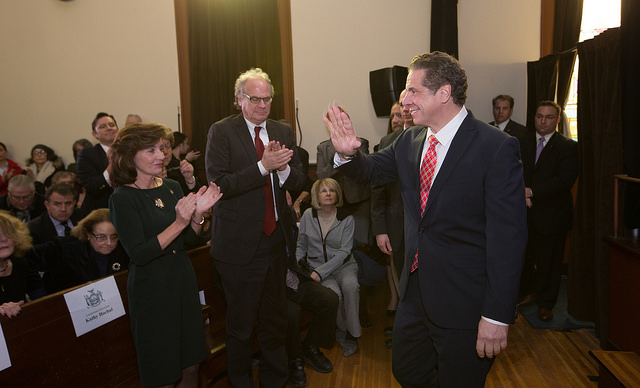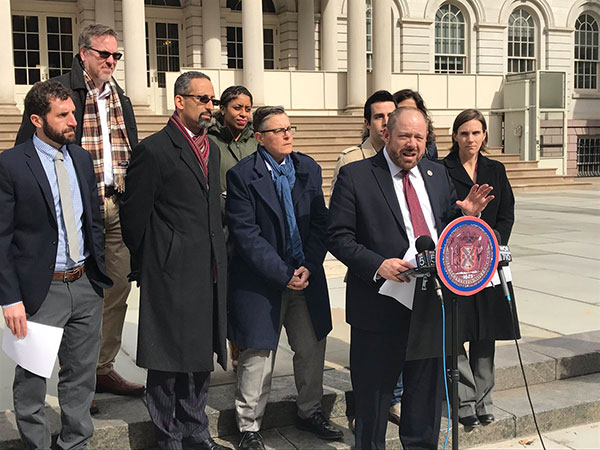A Blueprint for Investing in Vulnerable Young Girls

Ana Oliveira, the author
A study released last month in the journal Science found that by age six, girls are already less likely to see themselves and other girls and women to be as brilliant and capable as boys. While this applied to girls regardless of race and income, a report released in November by The New York Women’s Foundation highlights the particular challenges faced by low-income girls, particularly immigrant girls and girls of color, and the critical need to support their mothers and caretakers in order to promote their progress.
New York City is home to 450,000 girls under the age of eight. Fully three-quarters live in communities of color or immigrant communities. As many as 40% live in poverty.
These girls clearly embody the vibrant, diverse future of our city. Last fall, every poster announcing New York’s new universal pre-K program prominently displayed at least one of those little girls’ shining faces, inspiring deep feelings of warmth and protectiveness.
The problem is that tender feelings and a single additional year of schooling are far from sufficient to meet these girls’ needs. The first eight years of a child’s life comprise a period of both unique vulnerability and unparalleled cognitive, physical, and social-emotional development. Ensuring solid health and progress for low-income girls thus requires ensuring that they receive strong, consistent nurturance from well-supported and well-prepared adults – 24/7 – across all those critical years of learning and growth.
And that is where we run into trouble.
Our report, Blueprint for Investing in Girls Age 0-8 from The New York Women’s Foundation, clearly shows that our society has remained stubbornly resistant to adopting measures that would ensure fair protection, just compensation, adequate support, and strong preparation to the low-income women of color who are raising these girls.
Here are the facts:
--Low-income mothers have highly-limited access to the basic guidance, reassurance, and respite that all mothers need to be effective nurturers and first teachers. While mothers of means can typically avail themselves of an array of supports – from culturally-appropriate parenting groups to knowledgeable nannies to classes explaining just how to boost a child’s reading skills – there exist no comparably- and consistently-accessible resources for all the low-income mothers whose core childrearing challenges are inevitably further exacerbated by the tolls of poverty.
--Low-income women of color are overwhelmingly both the main (or sole) wage earners and the main (or sole) caregivers for their families. They are concurrently responsible for paying their families’ core bills, providing or arranging for their children’s round-the-clock care, and serving as the backbone of our city’s low-wage workforce. Yet, New York City currently provides only some 36,000 slots of direct, subsidized childcare to cover the needs of the hundreds of thousands of working mothers who cannot possibly afford market-rate care. And even the families that qualify for the subsidy often find the slots to be geographically inaccessible, financially unaffordable, or unavailable at the moment that they need them.
--The (predominantly non-white, female) workers who staff the city’s subsidized childcare programs earn salaries that put them barely over the poverty line themselves. And the even larger cadre of informal caregivers employed by most working mothers have only limited access to the ongoing training, support, feedback, and supervision that their vitally-important work merits – and requires.
--The service and retail jobs that low-wage working women overwhelmingly hold are typically characterized by minimal pay scales, erratic hours, and total lack of flexibility. Low-wage working mothers therefore not only battle to simultaneously meet their families’ caregiving and economic needs – they struggle fiercely to dovetail those childcare arrangements to the sudden fluctuations of their working hours and to ensure that someone is on hand to handle the emergencies that can arise in any family.
Fortunately, the situation is not completely grim. Across the city, a range of sterling efforts are leading the way to improvement on all those critical fronts.
They include:
--The Nurse-Practitioner Partnership and Healthy Families programs, which offer up to two years of intense, culturally-appropriate in-home guidance and support to a small but crucial segment of the city’s youngest and most vulnerable mothers.
--A range of service agencies – like BOCNET, Whedco and the five members of the Child Care Resource and Referral Consortium (CCRC) – that are working to improve and extend low-wage families’ access to high-quality affordable childcare and provide robust training and supports to formal and informal childcare providers.
--A group of advocacy organizations – for example, A Better Balance – which are doggedly seeking fairer and more viable employment practices and conditions for working parents.
These and other similar efforts are creating a track record of solid success. All are eminently expandable and replicable – given the will and the resources.
The experts strongly agree: If we want the low-income girls of our city to be as healthy, stable, and successful as possible, we need to better recognize, respect, and bolster the strengths of the low-income women of color who hold these girls’ futures in their hands.
For not only are those women these girls’ main caregivers and providers, they are also their main role models. And so, if we continue to underpay, exploit, and under-support those adult women, we are offering those girls a very discouraging vision of their own potential adult destinies.
Don’t we owe the future leaders of our families, communities, and workforce something better than that?
***
Ana Oliveira is President & CEO of The New York Women’s Foundation.
***
Have an op-ed idea or submission for Gotham Gazette? Email This email address is being protected from spambots. You need JavaScript enabled to view it.
No Path for Cuomo 2020

Gov. Cuomo (photo: The Governor's Office)
Governor Andrew Cuomo’s unconventional whirlwind State of The State tour has, once again, gotten political pundits pondering the depths of his national ambition, three years out from the next Presidential election.
Much like his father Mario’s legendary Danish Prince act in 1988, as well as his encore performance of 1992, Cuomo the Younger has openly flirted with a White House bid of his own in the past, and with the Democratic bench now resembling an intramural volleyball team, you’d think the chances of Cuomo securing his party’s nomination would be looking pretty good.
Assuming his ever-expanding campaign coffers, currently $21.9 million fat, buy him a third term as governor in 2018, Cuomo would then enter 2020 an automatic top-tier presidential candidate. But what’s his constituency?
Cuomo will likely have to compete with charismatic rock star candidates Cory Booker and Elizabeth Warren, maybe even Kamala Harris, in addition to Amy Klobuchar, Chris Murphy, Martin O’Malley, and possibly his own home state’s junior Senator Kirsten Gillibrand, though she says her primary focus is running for re-election next year. Colorado Governor John Hickenlooper might also join the fray, among others.
After accepting $18 million in campaign contributions from the financial, real estate, lobbying, and insurance industries, it is doubtful Cuomo’s candidacy would resonate very deeply amongst the fiercely populist, anti-corporate liberal grassroots millennials and other left wing special interest groups that are a natural fit for Senators Warren and Booker.
Meanwhile, others, like O’Malley and Gillibrand, might find common cause with the more centrist New Democrats of the Clinton era – a group that ought to be a key Cuomo demographic.
But why would Iowa caucus-goers cast their vote for a career politician and successor to a nearly 40-year-old political dynasty rather than a fresh face? What does New Hampshire get with Cuomo that they don’t get with someone like Warren? Will African-Americans in South Carolina pull the lever for a 63-year-old Italian-American from Queens if Cory Booker or Kamala Harris is on the ballot?
Since being sworn in six years ago, Andrew Cuomo has largely toed the yellow middle line of caution, displeasing hardcore Democrats enough to draw two primary challengers in 2014, who went on to garner 40% of the vote. Cuomo’s infamous Working Families Party “hostage video” is a stark reminder that Cuomo has struggled to consolidate or inspire the base of his party. “Progressive” efforts since have smacked of desperation as he apparently eyes 2018 and 2020. Most Democrats in New York still don’t trust Cuomo.
And if he can’t inspire the base then how can he expect to emerge triumphant from a Presidential primary rife with younger, more appealing progressive leaders?
On Cuomo’s watch, New York has become a state with the second highest debt in the nation, according to the most recent U.S. Census Bureau data (2014); second highest Medicaid costs, based on a 2015 Kaiser Family Foundation analysis; seventh highest income tax rate; eleventh highest property tax rate; a shrinking population; crumbling infrastructure; habitual spending increases; and 3 million residents receiving food stamps.
Also, lest we forget, the governor’s second term has so far seen the convictions of both former Assembly Speaker Sheldon Silver and State Senate Majority Leader Dean Skelos on charges of corruption, as well as the arrests of top Cuomo advisor Joe Percoco, former aide Todd Howe, SUNY Polytechnic Institute President Alain Kaloyeros, and seven others amidst a massive bid-rigging and corruption scandal.
Were he to run for President, it seems unlikely Cuomo would be able to escape the ubiquitous scrutiny of his administration’s failed ethics as well as its failure to provide substantive ethics reform to New York government and politics.
Cuomo has made a career out of being a pragmatist. Despite all the buzz from talking heads trying to fill out their round-the-clock coverage, even he would begrudgingly admit that a third term in Albany might very well prove to be the apex of his decades long political career.
***
John William Schiffbauer was the Deputy Communications Director for the New York Republican State Committee 2014-16. Last fall, he served as campaign manager for Republican Melinda Crump’s State Senate campaign in New York’s 31st District.
***
Have an op-ed idea or submission for Gotham Gazette? Email This email address is being protected from spambots. You need JavaScript enabled to view it.
Broken Windows Policing Will Fuel the Trump Deportation Machine

City Council Member Rory Lancman, the author (photo: @RoryLancman)
We’re now more than 30 days into Donald Trump’s presidency, and it is already crystal clear that the hostile and offensive rhetoric he used toward immigrants on the campaign trail will be put into practice by his administration.
It was just this week that Trump’s Department of Homeland Security issued new rules that make clear Trump’s plan to deport millions of immigrants from our country, while tearing apart families and communities in the process.
With thousands, if not tens of thousands, of immigrant New Yorkers now at risk of deportation, it is urgent that Mayor Bill de Blasio take real action to protect immigrant New Yorkers from possible deportation under Trump.
The mayor has had no problem in recent weeks talking about opposing Trump and his policies, but when it comes down to it, talk is cheap. Real leadership requires bold action, and immigrant New Yorkers deserve action.
But, here is the reality facing New York City today: Mayor de Blasio’s broken windows policing will now be the fuel for Donald Trump’s deportation machine.
Without important and necessary action from the mayor, New Yorkers who are arrested for minor, nonviolent offenses could now be subject to deportation. That is inhumane and completely contrary to our values.
Mayor de Blasio has the authority to take action immediately to protect immigrant New Yorkers -- without having to wait for the City Council, the State Legislature, or Congress. On his own, the mayor can direct the NYPD to stop arresting people, including immigrant New Yorkers, for low-level, nonviolent, quality-of-life crimes where a civil alternative is already readily available.
Take fare evasion, for example. In 2015, more than 100,000 New Yorkers were stopped by the NYPD for fare evasion. Nearly 30,000 New Yorkers were arrested for “theft of services,” a misdemeanor under the state penal law. The remaining individuals were issued a civil summons for violating the MTA rule against fare evasion, which is not subject to any kind of criminal sanction.
The difference between an arrest and a civil violation for fare evasion is monumental. A conviction for fare evasion could result in jail time, appear on an individual’s criminal record, and staggeringly enough, result in deportation for even documented immigrants like legal permanent residents of New York.
On the other hand, a civil violation is heard by the MTA’s Transit Adjudication Bureau, not a criminal court, and cannot result in jail time or deportation.
As Mayor de Blasio’s broken windows policing continues in this city, it is clear who is being targeted -- 92% of the arrests for fare evasion in 2015 were people of color. Oftentimes, too, if an individual cannot immediately produce an ID, the NYPD will choose to make an arrest, instead of issuing a civil violation.
All told the risk of arrest for immigrant New Yorkers for fare evasion is all too real. And for undocumented immigrants, any interaction with the criminal justice system, even for a minor offense like fare evasion, can result in deportation.
With the stakes so high for so many in our city, it is up to the mayor to determine if he is going to use his authority to protect people, or silently feed into Trump’s deportation machine. Talking about standing up to Donald Trump is one thing, but actually taking action is far more important.
New Yorkers are counting on the mayor to do what’s right and take a real, actionable stand for our values against Trump.
***
City Council Member Rory Lancman represents parts of Queens and chairs the Council's Committee on Courts and Legal Services. On Twitter @RoryLancman.
***
Have an op-ed idea or submission for Gotham Gazette? Email This email address is being protected from spambots. You need JavaScript enabled to view it.




